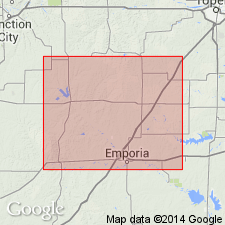
- Usage in publication:
-
- Barclay limestone
- Modifications:
-
- Original reference
- Dominant lithology:
-
- Limestone
- Shale
- AAPG geologic province:
-
- Forest City basin
Summary:
Pg. 175. Barclay limestone. Proposed by G.I. Adams, in unpublished manuscript [USGS Bull. 211], for limestones interbedded with shales, about 70 feet thick, intimately connected faunally. Overlies Burlingame [Scranton] shales and underlies Willard shales. Recognized in eastern Kansas. Age is Pennsylvanian.
[Probably named from town of Barclay, Osage Co., eastern KS.]
Source: US geologic names lexicon (USGS Bull. 896, p. 111).

- Usage in publication:
-
- Barclay limestone†
- Modifications:
-
- Abandoned
- AAPG geologic province:
-
- Forest City basin
Summary:
Pg. 111. †Barclay limestone. This name fell into disuse years ago. As defined it included several limestones. According to R.C. Moore, 1936 (Kansas Geol. Survey Bull., no. 22, p. 215), Barclay limestone of Beede extended from top of Scranton shale up to base of Willard shale (just as defined by Beede), but Moore's Willard shale is a younger shale than the Willard of current [ca. 1938] literature. Moore discarded this name. [Replaced with Tarkio member of Wabaunsee formation.]
Source: US geologic names lexicon (USGS Bull. 896, p. 111).
For more information, please contact Nancy Stamm, Geologic Names Committee Secretary.
Asterisk (*) indicates published by U.S. Geological Survey authors.
"No current usage" (†) implies that a name has been abandoned or has fallen into disuse. Former usage and, if known, replacement name given in parentheses ( ).
Slash (/) indicates name conflicts with nomenclatural guidelines (CSN, 1933; ACSN, 1961, 1970; NACSN, 1983, 2005, 2021). May be explained within brackets ([ ]).

